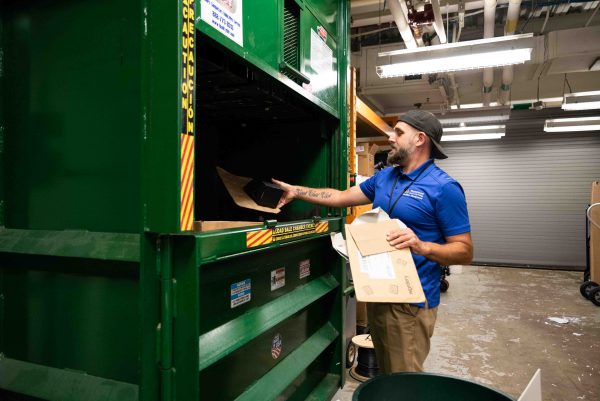

Kevin Losey, a facilities management employee, sorts through recycled paper to compress before shipping to the local drop-off station. Lily Merritt | Washtenaw Voice
| Tips to reduce individual waste: |
|
By Brian Babcock
Staff Writer
If someone wants to know how much rubbish they produce in a lifetime, there is a simple formula to approximate this amount.
Simply taking one’s bodyweight and multiplying it by 600 will show approximately how much garbage each United States citizen produces, according to the WCC recycling operations website. For example, a person with an average weight of 150 pounds, over the course of their life, would go through roughly 90,000 pounds of trash.
According to WCC’s Waste and Resources Report FY2019 data, the college has discarded over 996,000 pounds of waste a year. Roughly 451,000 pounds is put in the landfill and 474,000 is either composted or recycled.
WCC and its students are taking steps to help reduce the amount of waste produced at the college, promote sustainability and provide a cleaner environment.
Rebecca Andrews is the recycle operations manager on campus and sees the impact of recycling first-hand.
“It’s a lot of trash that people are making . . . we’ve got nearly 500 tons of material that is discarded every year,” Andrews said.
According to Andrews, recycling at WCC is hand-sorted, which allows for composting.
One way to lessen adverse waste disposal is to prevent biodegradable material from heading to the landfill; when it breaks down it produces methane, which is more potent than C02.
Recycling habits also affect the employees who are directly sorting the materials.
“The waste hierarchy [reduce, re-use, recycle, recover, landfill] is the way you should approach your waste management . . . here at WCC it all starts with the student. The student takes their pop bottle, they put it in the green bin, the custodians empty the green bins and then the recycle team takes the bottles back to our sorting area where they do a hand-sort to remove any contaminants . . . then it’s shipped off-site to the local drop-off station,” she said. “It’s the same setup with paper and cardboard.”
Jack Evans, a student at the college, does his part to help reduce the amount of trash on campus.
“I try to re-use and throw away as little as I can and whatever I do end up using, like for lunches, I either take home with me or try to recycle,” Evans said.
Evan’s also said helping out doesn’t necessarily require big changes in lifestyle.
“It’s tiny things that I can do . . . I can bring reusable stuff [for lunches] instead of buying the food from the cafeteria. They give you so many things which you can just throw out right after.”
The key to contributing is to start small. An example of this is the way Evans reuses plastic water bottles for a week and uses Tupperware for his lunches. Though it may be easier to do, not everything has to be thrown away immediately after use.
Below are recent employment want ads that have been posted with WCC Center for…
Sasha Hatinger | Staff Writer What's the link between technology and its users' mental health? …
This review may contain spoilers for “The Monkey”, released in theatres on Feb. 21, 2025. …
Pop music gets an upgrade with singing robots in Steampunk suits Lily Cole | Editor …
Lily Cole | Editor ONGOING COVERAGE As new executive orders come out, some of which…
Public safety will follow federal law, verify warrants Courtney Prielipp | Photo Editor Recent…